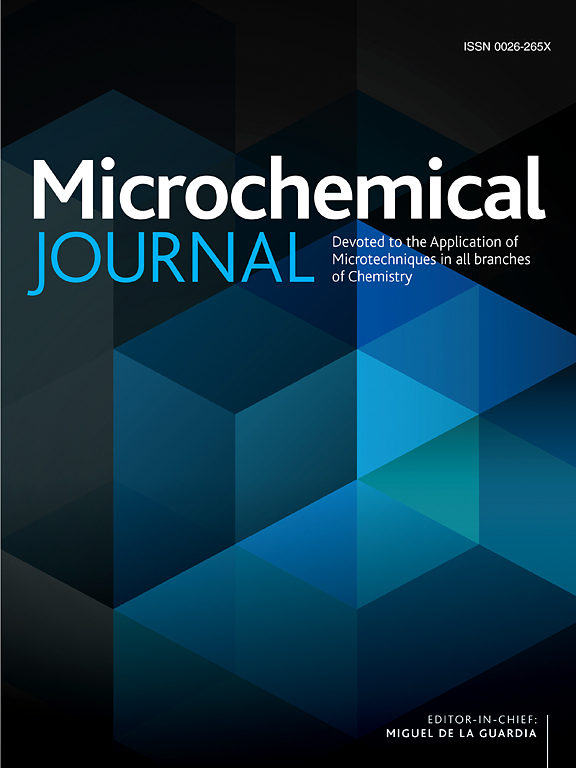基于竞争性识别策略的荧光适配传感器和用于检测脑钠肽的床旁检测系统
IF 4.9
2区 化学
Q1 CHEMISTRY, ANALYTICAL
引用次数: 0
摘要
脑钠肽 (BNP) 是临床分析的首选生物标志物,广泛用于心血管和神经系统疾病的早期筛查和预后监测。由于 BNP 在血液中的浓度低、半衰期短,对其进行灵敏检测仍是一项必须克服的挑战。随着分子诊断和床旁检测(POCT)的快速发展,开发一种灵敏度高、稳定性好、准确性高、速度快、成本低的 BNP 生物传感器对临床应用和紧急诊断具有重要意义。然而,人体血液中的 BNP 以各种形式存在,传统的荧光传感器可能会导致浓度被高估。在这项工作中,我们构建了一种基于竞争性识别策略的 "开启式 "荧光适配体传感器,用于定量检测 BNP,并构建了基于智能手机的荧光传感检测系统,以实现现场快速检测。我们设计了一种用羧基荧光素(FAM)标记的特异性适配体,该适配体结构简单、生物亲和性高,可选择性捕获 BNP,并利用羧基氧化石墨烯(GO-COOH)的大比表面积和优异的荧光淬灭效果作为适配传感器的载体和淬灭剂。通过优化适配体和 GO-COOH 的浓度以及淬灭/恢复时间等实验参数,在 0.01 ng/mL-10 ng/mL 的浓度范围内实现了对 BNP 的线性灵敏检测,检测限低至 10 pg/mL,具有良好的特异性,在人工血清添加实验中具有极佳的应用潜力。此外,针对便携式检测的需求,我们还开发了一套稳定、灵敏的荧光信号采集系统,突破了传统荧光检测设备的使用环境,填补了便携式荧光生物传感的空白。综上所述,我们创造性地提出了一种能快速灵敏检测 BNP 的荧光适配传感器,并开发了低成本的荧光生物传感器。它与 POCT 的结合具有广阔的应用前景,同时也为其他蛋白质生物标记物的荧光检测提供了一些思路。本文章由计算机程序翻译,如有差异,请以英文原文为准。

Fluorescent aptasensor based on competitive recognition strategies and point-of-care testing system for brain natriuretic peptide detection
Brain natriuretic peptide (BNP) is the preferred biomarker for clinical analysis, widely used in early screening and prognostic monitoring of cardiovascular and neurological diseases. Due to the low concentration and short half-life of BNP in the blood, its sensitive detection remains a challenge that must be overcome. With the rapid development of molecular diagnosis and point-of-care testing (POCT), developing a BNP biosensor with high sensitivity, good stability, accuracy, speed, and low-cost is of great significance for clinical applications and emergency diagnosis. However, BNP in human blood exists in various forms, and traditional fluorescence sensors may lead to overestimation of the concentration. In this work, we constructed an “on” fluorescent aptasensor based on competitive recognition strategy for quantitative detection of BNP, and built a fluorescence sensing detection system based on smartphone to achieve rapid on-site detection. We designed a specific aptamer labeled with carboxyfluorescein (FAM) with a simple structure and high biological affinity for selective capture of BNP, and utilized the large specific surface area and excellent fluorescence quenching effect of carboxylated graphene oxide (GO-COOH) as a carrier and quencher for the aptasensor. By optimizing experimental parameters such as aptamer and GO-COOH concentrations, as well as quenching/recovery time, linear sensitive detection of BNP was achieved in the concentration range of 0.01 ng/mL–10 ng/mL, with a detection limit as low as 10 pg/mL, good specificity, and excellent application potential in artificial serum spiking experiments. Additionally, a stable and sensitive fluorescence signal collection system has been developed to meet the needs of portable detection, breaking through the usage environment of traditional fluorescence detection equipment and filling the gap of portable fluorescence biosensing. In summary, we have creatively proposed a fluorescent aptasensor that enables rapid and sensitive detection of BNP and the development of low-cost fluorescent biosensors. The combination with POCT has shown broad application prospects and also provides some ideas for the fluorescence detection of other protein biomarkers.
求助全文
通过发布文献求助,成功后即可免费获取论文全文。
去求助
来源期刊

Microchemical Journal
化学-分析化学
CiteScore
8.70
自引率
8.30%
发文量
1131
审稿时长
1.9 months
期刊介绍:
The Microchemical Journal is a peer reviewed journal devoted to all aspects and phases of analytical chemistry and chemical analysis. The Microchemical Journal publishes articles which are at the forefront of modern analytical chemistry and cover innovations in the techniques to the finest possible limits. This includes fundamental aspects, instrumentation, new developments, innovative and novel methods and applications including environmental and clinical field.
Traditional classical analytical methods such as spectrophotometry and titrimetry as well as established instrumentation methods such as flame and graphite furnace atomic absorption spectrometry, gas chromatography, and modified glassy or carbon electrode electrochemical methods will be considered, provided they show significant improvements and novelty compared to the established methods.
 求助内容:
求助内容: 应助结果提醒方式:
应助结果提醒方式:


